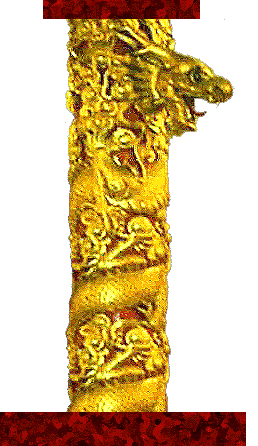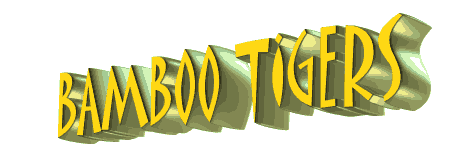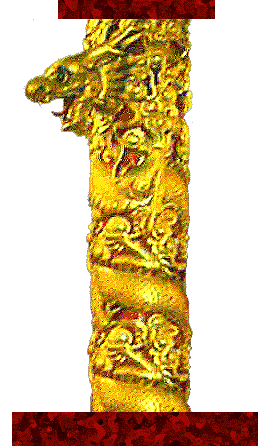| |
Dan Foley recalled that the first week the Gang Task Force was in operation, he and his partner, Fred Mollat, parked downtown and struck out for Chinatown on foot. They were used to sidewalks crowded with people from curb to wall in the tourist areas of the city. Chinatown's traffic was another thing. In normal times, the consensus among San Franciscans was that you took your life in your hands when you drove through the Oriental quarter. "Chinese driver" jokes, unfair, but often uncomically true, were a constant theme.
Walking in was the best way, starting at Grant and Bush and pushing past the fierce grimaces of the stone foo dogs at the foot of the pailou arch crossing Grant Avenue. The stylized dogs looked more leonine than canine and seemed to growl, "Take care, all who enter here," but there might as well have been kittens on duty that week. It was a ghost town beyond the arch. September marked the end of the tourist season, of course, but even the Chinese weren't on the streets.
Foley and Mollat strolled up the incline that crests between Pine and California Streets. The shops specializing in bric-a-brac and souvenir trinkets were as deserted of customers as were those selling high-priced antiques, porcelains, gold jewelry and pearls.
At California, the cops glanced eastward toward the Financial District. The never-ending flow of traffic crossing through the canyon of high-rises on Montgomery indicated that business perked along as usual on the "Wall Street of the West," only two blocks from Chinatown.
Looking westward up the steeps of towering Nob Hill, they could see a grande dame trio of carriage-trade hotels--The Fairmont, The Mark Hopkins and The Stanford Court--whose acres of windows glimmered in the late-morning sun. A cable car coasted downhill toward Grant, its bells clanging to clear away pedestrians and automobiles from tracks singing with the vibrating cables that pulled San Francisco's "Toonerville trollies." The mobile monuments always demanded the right of way.
Nobody got off at Grant.
Across California Street, a silver-and-red tinsel dragon at the Chinatown Wax Museum (now replaced by a McDonald's Restaurant) pranced to attract visitors inside, but that morning it pranced in vain. The plainclothesmen had long since toured the life-size dioramas that told the story of the Chinese in California. Almost no one else was around to take notice.
Foley stepped under the pagoda eaves of the public telephone booth beside Old St. Mary's Church and checked in with the Dragon Force. "We're on the street in Chinatown," he reported during his call. "Nothing interesting so far. We'll stop by the Golden Dragon."
An eerie mood struck them when they turned into Washington Street a few minutes later. They thought of all those murders and what had gone on in the Golden Dragon. A couple of wary tourists snapped camera shots of the restaurant from the corner of Waverly Place and then scurried away. Foley and Mollat went inside. There were few customers, and there was no loud talking. A skeleton staff of waiters lingered disinterestedly near the kitchen door. Normally, it would have been crowded with the early luncheon crowd, but people just weren't coming down to Chinatown, and especially not to the Golden Dragon.
The two policemen identified themselves to the cashier, actually the manager, a man named Ng. He made no reply, but watched through narrowed eyes as Foley and Mollat walked around looking at the bullet holes dotting the walls. A silent echo of fear hung over the place like a cloud.
In the first hours of investigation on the scene, Ballistics had stuck chopsticks into the holes. The angles at which the plastic sticks protruded indicated trajectories of shots. The crew had thus been able to deduce firing patterns. Bullets found in the walls or in the bodies of the wounded and the dead, when matched with the weapons that fired them--if the weapons were ever found--would be helpful in determining which person had been shot by which shooter. Such information would be crucial in court when preparing counts of murder or assault--if the killers ever came to trial.
Foley and Mollat were conscious of the importance of every detail and scanned the restaurant for any visual information which might have been missed. They realized they were dealing with a world-class crime. The incident had become more than a local affair. Already nearly two weeks past, it had been publicized throughout the United States and around the globe. In Rio, in Naples, in Hong Kong, in Sydney, in Capetown--the other five of the six loveliest harbor cities on earth--San Francisco and its Golden Dragon were still in the news.
From the beginning, the international press picked up on the angle of a youth-gang war. Suggestions poured in from everywhere. Extremists thought Chinese gang kids in San Francisco should be rounded up and sent "back to China." Others felt Hong Kong police agents should be brought over to investigate the case. A local group, Chinese for Affirmative Action, went on the radio to denounce The City for not rushing paramedics to the scene faster because the incident occurred in an ethnic area and for not having an emergency hospital nearer Chinatown. Both allegations, under the circumstances, were specious. Ambulances made it to the scene in record time, and only the trauma team at San Francisco General Hospital, on the other side of town, was equipped to handle mayhem of this magnitude.
Reports and phone calls regarding all Chinese activities vaguely suggestive of being gang connected were beginning to come into the Gang Task Force from other units and stations throughout San Francisco and beyond.
The F.B.I. called to say that an informant told them that one of the getaway drivers after the Golden Dragon massacre was a woman, and that the getaway auto went south on the freeway toward San Jose. The woman was presumed to be the wife of someone who was killed at Stockton and Pacific several years ago and she was alleged to be living with a member of the Joe Boys. As a lead, it came to nothing, but it had to be checked out.
Police in Washington, D.C., supplied information that a Chinese male in his late teens, who spoke only Chinese, had arrived there from the West Coast seeking employment. Members of the Chinese community in the nation's capital suspected he might be connected with the recent homicides in San Francisco. He wasn't, but, again, the Force had to make sure.
One significant lead came out of the preliminary investigation right after the massacre. There was a cook at Sam Woh's Restaurant on Washington Street, a few doors down and across the street from the Golden Dragon. The cook swore he had seen the shooters get out of a car and flee in it after the shooting. He described the car and said there was a backup car, as well. He seemed on the edge of giving out a license number, too, but the restaurant's owner stepped in and told him in Cantonese, "Shut up! Don't tell these guys anything!" That was the end of the cook's tale. The wall of silence, once conjured up, always stood fast.
When Foley and Mollat returned to the Hall of Justice on the day of their visit to the Golden Dragon, they walked into an atmosphere quite different from the funereal one pervading Chinatown. The Gang Task Force was functioning in a state of chaos.
Still confined to a cubbyhole down the hall from Homicide, in spite of Chief Gain's lavish promises of space and equipment, the new quarters had room for two or three guys at a time. The rest floated around the corridor or found a chair in Homicide when they weren't hitting the streets. There were no filing cabinets for storing mug shots, no typewriters, no tape recorders. No vehicles were assigned. The car Foley and Mollat used for driving near enough to Chinatown to walk in on Grant Avenue was a loan-out Mollat had "borrowed" from Intelligence. Three weeks later, he had to give it back. In the words of urbane Inspector John McKenna, "The logistical needs of a paramilitary unit were sadly lacking."
An effort was made to solve the problem by splitting shifts and juggling schedules to keep everybody moving in a circle from home to office to streets to home. Typical of everyone in the Force, Foley and Mollat were assigned days Monday through Thursday, nights on Friday and Saturday, and afternoons on Sundays. They were expected to cover everything from the schools by day, to Chinatown by day and by night, to leads on the Golden Dragon case in whatever hours remained. They were ordered to report on an on-and-off basis at the Operations Center, where they also had to pick up a key for the Homicide office when working nights. Lt. Murphy wanted everything covered with very few men. It was hectic.
| |
|









